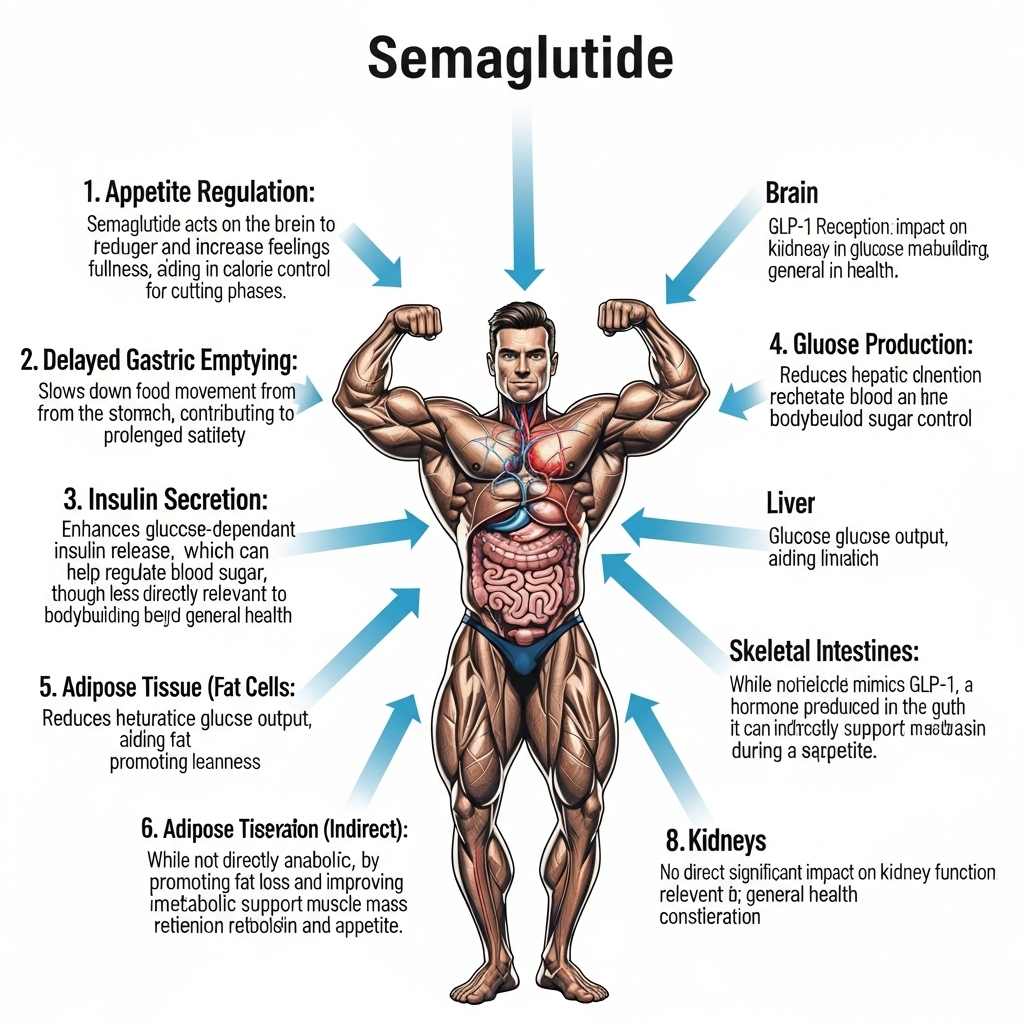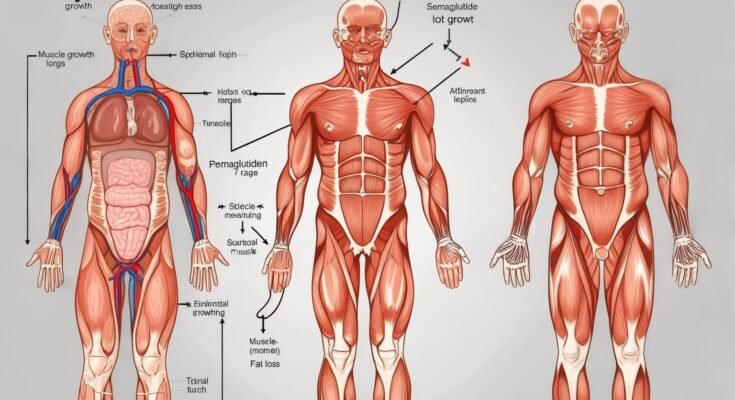The intersection of GLP-1 receptor agonist fitness applications and bodybuilding has sparked intense interest among athletes, physique competitors, and fitness enthusiasts. Understanding semaglutide muscle loss prevention strategies, optimizing semaglutide protein intake requirements, and developing an effective semaglutide workout routine are critical for anyone considering this medication during a cutting phase. This comprehensive guide explores how to build muscle on Ozempic , compares tirzepatide vs semaglutide bodybuilding applications, and provides evidence-based strategies for maintaining gains on semaglutide.
Understanding Semaglutide for Bodybuilders

Before diving into semaglutide peptide bodybuilding protocols, it’s essential to understand how GLP-1 agonists bodybuilding effects differ from traditional weight loss approaches.
Semaglutide is a glucagon-like peptide-1 (GLP-1) receptor agonist originally developed for type 2 diabetes management. The mechanism behind weight loss drugs muscle preservation challenges includes appetite suppression through reduced hunger signals in the hypothalamus, increased satiety after meals, and decreased food cravings. Metabolic effects enhance insulin sensitivity, slow gastric emptying, reduce glucagon secretion, and improve glycemic control. Body composition impact promotes significant fat loss, may affect lean muscle mass without intervention, and influences nutrient partitioning.
Understanding these mechanisms is crucial for developing an effective semaglutide recomp strategy that maximizes fat loss while preserving hard-earned muscle tissue.
The semaglutide cutting cycle differs significantly from conventional bodybuilding cuts. Traditional cuts rely on caloric deficit through diet control, require significant willpower for appetite management, typically involve moderate fat loss rates, and hunger remains a constant challenge. Semaglutide-enhanced cuts provide appetite suppression that makes caloric deficit easier, accelerated fat loss potential, risk of excessive muscle loss without proper protocol, and require strategic nutrient timing semaglutide approaches.
This comparison highlights why building muscle while on weight loss medication requires specialized knowledge and careful planning.
Does Semaglutide Cause Muscle Wasting?
One of the most critical concerns for athletes is whether does semaglutide cause muscle wasting. Research and anecdotal evidence from semaglutide bodybuilding forum discussions reveal important insights.
Clinical studies show that weight loss from semaglutide includes both fat mass and lean tissue reduction. Key findings include average weight loss composition of 60-70% fat mass and 30-40% lean tissue, greater muscle loss risk with aggressive caloric deficits, potential for sarcopenia prevention weight loss drugs interventions, and individual variability based on training and nutrition. This data underscores the importance of semaglutide muscle loss prevention strategies for bodybuilders and athletes.
Understanding why muscle loss occurs helps develop effective preservation strategies. Reduced caloric intake from severe appetite suppression may lead to inadequate protein consumption, insufficient energy for muscle protein synthesis, and potential anabolic resistance semaglutide effects. Metabolic adaptations include changes in hormone levels (insulin, IGF-1), altered nutrient partitioning, and potential impact on testosterone levels on semaglutide. Training interference manifests as reduced energy for intense workouts, decreased training volume tolerance, and recovery challenges.
These factors emphasize why preserve muscle mass during semaglutide requires proactive intervention.
Semaglutide Protein Intake Requirements for Muscle Preservation
The foundation of semaglutide muscle loss prevention is adequate protein consumption. Successfully combining semaglutide and lean muscle mass goals requires comprehensive planning across nutrition, training, and supplementation.
Recommended protein targets include a minimum of 1.0-1.2g per pound of lean body mass, optimal at 1.2-1.6g per pound of lean body mass, and aggressive preservation at 1.6-2.0g per pound of lean body mass.
High protein diet semaglutide bodybuilding strategies should prioritize protein at every meal, use best protein powder with semaglutide between meals, front-load protein early in eating window, and consider amino acid requirements GLP-1 drugs supplementation.
Protein timing considerations include pre-workout protein (20-40g), post-workout protein (30-50g), before bed casein (30-40g), and distribution throughout day (every 3-4 hours). These semaglutide protein intake requirements exceed standard recommendations to offset potential muscle loss.
How to Build Muscle on Ozempic: Training Strategies
How to build muscle on ozempic requires strategic resistance training with GLP-1 medications. Your semaglutide workout routine should prioritize compound movements like squats, deadlifts, bench press, and rows for maximum muscle recruitment, efficient training stimulus, and strength maintenance focus.
Maintain training volume by not reducing sets or reps significantly, preserve training frequency (4-6 days/week), focus on progressive overload when possible, and monitor recovery carefully. Adjust training intensity by potentially reducing working weights 5-10%, focusing on form and muscle engagement, using intensity techniques strategically (drop sets, rest-pause), and avoiding excessive junk volume.
A sample strength training program on semaglutide includes Day 1 for upper push with bench press 4×6-8, incline dumbbell press 3×8-10, overhead press 3×8-10, lateral raises 3×12-15, and tricep work 3×10-12. Day 2 focuses on lower body with squats 4×6-8, Romanian deadlifts 3×8-10, leg press 3×10-12, leg curls 3×10-12, and calf raises 4×12-15. Day 3 covers upper pull with deadlifts 4×6-8, pull-ups or lat pulldowns 3×8-10, barbell rows 3×8-10, face pulls 3×12-15, and bicep work 3×10-12. Day 4 is rest or active recovery. Day 5 features full body power with power cleans 4×5, front squats 3×6-8, bench press 3×6-8, and pull-ups 3×8-10.
This semaglutide workout routine emphasizes muscle preservation through consistent stimulus and adequate volume.
Meal Plan Semaglutide Muscle Gain Strategy
Creating an effective meal plan semaglutide muscle gain strategy requires balancing appetite suppression with nutritional needs.
For a 200lb bodybuilder, macronutrient targets include protein at 240-320g daily, fats at 60-80g daily for hormone support, carbohydrates at 150-250g daily for training fuel, and total calories at 2,200-2,800 representing a moderate deficit.
Sample daily meal plan starts with Meal 1 at 7 AM featuring 6 egg whites plus 2 whole eggs, 1 cup oatmeal, and berries providing 45g protein, 50g carbs, 15g fat. Meal 2 at 10 AM includes a protein shake with best protein powder with semaglutide, 1 banana, 1 tbsp almond butter providing 40g protein, 35g carbs, 10g fat. Meal 3 pre-workout at 12:30 PM contains 8oz chicken breast, 1 cup white rice, vegetables providing 55g protein, 45g carbs, 5g fat. Meal 4 post-workout at 3 PM features 8oz lean beef, medium sweet potato, green vegetables providing 50g protein, 40g carbs, 12g fat. Meal 5 evening at 6 PM includes 8oz salmon, 1 cup cooked quinoa, mixed vegetables providing 45g protein, 35g carbs, 18g fat. Meal 6 before bed at 9 PM contains casein protein shake, small handful mixed nuts providing 35g protein, 10g carbs, 15g fat.
Daily totals reach 270g protein, 215g carbs, 75g fat equaling 2,595 calories. This high protein diet semaglutide bodybuilding approach prioritizes muscle preservation while allowing fat loss.
Semaglutide Bodybuilding Stack: Essential Supplements
An effective semaglutide bodybuilding stack addresses muscle preservation, recovery, and performance.
Creatine supplementation with semaglutide at 5g daily provides muscle retention, strength maintenance, and cell hydration benefits, timing anytime but post-workout is optimal, with synergy with resistance training. Essential amino acids (EAAs) at 10-15g during training support amino acid requirements GLP-1 drugs, minimize muscle breakdown during workouts, with BCAAs as an alternative though EAAs are superior.
High-quality protein powder includes whey isolate for post-workout with fast absorption and casein for nighttime with slow release, ensuring adequate leucine content (3g+ per serving), with best protein powder with semaglutide being low-carb and high-protein. Omega-3 fatty acids at 2-4g EPA+DHA daily provide anti-inflammatory benefits, hormone support, recovery enhancement, and may help preserve testosterone levels on semaglutide.
Vitamin D3 plus K2 at 4,000-5,000 IU D3 and 100-200mcg K2 supports hormone optimization and bone health, important during caloric deficit. Electrolytes including sodium, potassium, and magnesium combat side effects, support training performance, and are especially important with GI changes.
For experienced users considering peptide therapy for fat loss beyond semaglutide, advanced options include L-Carnitine for fat metabolism support (1-2g daily), Beta-Alanine for training endurance (3-5g daily), Citrulline Malate for pump and recovery (6-8g pre-workout), and digestive enzymes to combat semaglutide GI effects.
This semaglutide bodybuilding stack creates comprehensive support for maintaining gains on semaglutide.
Ozempic Bodybuilding Results: Realistic Expectations
Understanding realistic ozempic bodybuilding results helps set appropriate expectations and plan effective strategies.
For an 8-week semaglutide cutting cycle, typical results include total weight loss of 10-20 pounds, fat loss of 8-15 pounds, muscle loss without intervention of 2-5 pounds, and muscle loss with proper protocol of 0-2 pounds. For 16-week results, expect total weight loss of 20-35 pounds, fat loss of 18-28 pounds, with muscle preservation varying based on protocol adherence.
These semaglutide fitness transformation outcomes depend heavily on implementing proper semaglutide muscle loss prevention strategies.
Positive factors influencing results include high protein intake (1.6g+ per lb lean mass), consistent resistance training (4-6x weekly), adequate sleep (7-9 hours), progressive overload maintenance, and strategic supplementation. Negative factors include excessive caloric restriction, inadequate protein intake, reduced training volume, poor recovery, and ignoring semaglutide side effects bodybuilding implications.
Wegovy vs Ozempic vs Mounjaro for Bodybuilding
Comparing wegovy muscle building potential with other medications helps inform treatment selection.
Semaglutide (Ozempic/Wegovy) for bodybuilding offers advantages including established track record, extensive community experience (reddit semaglutide bodybuilding discussions), known dosing protocols, and predictable appetite suppression. Disadvantages include significant muscle loss risk without intervention, strong appetite suppression may hinder protein intake, and once-weekly injection schedule.
Tirzepatide vs semaglutide bodybuilding comparison shows tirzepatide (mounjaro for cutting phase) features dual GIP/GLP-1 agonist action, potentially greater fat loss, may offer better muscle preservation, but is newer with less community data and has similar muscle preservation requirements.
Head-to-head considerations reveal both require proactive muscle preservation strategies, tirzepatide shows slightly greater weight loss in studies, individual response varies, and cost and availability differ. The debate of tirzepatide vs semaglutide bodybuilding continues evolving as more athletes experiment with both.
Preventing Anabolic Resistance on Semaglutide
Understanding anabolic resistance semaglutide challenges helps optimize muscle protein synthesis despite caloric restriction.
Anabolic resistance refers to reduced muscle protein synthesis response to protein feeding, blunted response to resistance training, age-related phenomenon potentially exacerbated by GLP-1 medications, and requires higher protein doses for equivalent response.
Strategies to combat anabolic resistance include increasing per-meal protein to target 40-50g minimum per meal, ensuring 3g+ leucine per feeding, spacing meals 3-4 hours apart, and not allowing appetite suppression to reduce intake. Optimize training stimulus by maintaining or increasing training volume, focusing on eccentric loading, using full range of motion, and progressive overload where possible.
Strategic carbohydrate timing includes pre-workout carbs for energy, post-workout carbs for insulin response, supporting anabolic environment, and balancing with fat loss goals. Recovery optimization prioritizes sleep quality, manages stress levels, allows adequate rest between sessions, and monitors overtraining indicators.
These approaches help preserve muscle mass during semaglutide use despite potential anabolic resistance.
Semaglutide Dosage for Athletes and Bodybuilders
Determining optimal semaglutide dosage for athletes balances efficacy with performance maintenance.
Standard Ozempic/Wegovy titration follows weeks 1-4 at 0.25mg weekly, weeks 5-8 at 0.5mg weekly, weeks 9-12 at 1.0mg weekly, and week 13+ at 1.7-2.4mg weekly as tolerated.
Bodybuilding-specific considerations include starting lower to assess appetite impact, slower titration preserves training quality, may not need maximum dose, and individual response varies significantly.
Finding your optimal dose requires considering appetite suppression level, ability to meet protein requirements, training performance impact, side effect tolerance, and fat loss rate versus muscle preservation balance. Many bodybuilders find effectiveness at lower doses (0.5-1.0mg) than prescribed maximum, optimizing the balance between fat loss and performance.
Managing Semaglutide Side Effects in Bodybuilding
Understanding and mitigating semaglutide side effects bodybuilding athletes experience is crucial for success.
Common side effects affecting training include gastrointestinal issues like nausea (especially early treatment), reduced ability to consume large meals, timing protein intake around symptoms, and may affect pre-workout nutrition. Energy levels may show potential fatigue during adaptation, reduced workout intensity tolerance, and may need to modify training volume temporarily. Recovery challenges include delayed muscle recovery, reduced glycogen storage, and need for additional recovery time.
Mitigation strategies for GI issues include smaller more frequent meals, avoiding high-fat high-fiber before training, staying hydrated, considering digestive enzymes, and timing injection away from training days. For energy and performance, use strategic carbohydrate timing around workouts, adequate electrolyte supplementation, may need reduced training frequency initially, and prioritize quality over quantity in sessions. For recovery, increase sleep duration, implement active recovery sessions, maintain adequate protein consistently, and consider deload weeks.
Body Composition Tracking and Progress Monitoring
Accurate progress tracking prevents unwanted muscle loss and validates your semaglutide recomp strategy.
DEXA scan body composition semaglutide tracking provides precise body fat percentage, lean mass distribution, bone density assessment, and objective progress measurement. Recommended schedule includes baseline scan before starting, follow-up every 6-8 weeks, adjust protocol based on results, and track trends over time.
If DEXA scan body composition semaglutide tracking isn’t accessible, alternative tracking methods include bioelectrical impedance (less accurate but shows trends), progress photos for visual assessment of muscle retention, strength metrics to maintain or lose minimal strength, body measurements tracking key muscle group circumferences, and mirror assessment (subjective but useful).
Regular monitoring ensures your can you build muscle while taking semaglutide efforts are successful.
GLP-1 Receptor Agonist Fitness Applications Beyond Weight Loss
Understanding broader GLP-1 receptor agonist fitness applications helps contextualize semaglutide’s role in athletic performance and body composition.
Beyond simple weight loss, these medications influence metabolic health markers, insulin sensitivity improvements, inflammatory marker reduction, cardiovascular health benefits, and potential longevity effects. For athletes, this means improved nutrient partitioning during recomp phases, better glycemic control supporting performance, reduced systemic inflammation aiding recovery, and metabolic flexibility enhancement.
The emerging field of peptide therapy for fat loss continues expanding as research reveals additional mechanisms and applications. Understanding these broader contexts helps athletes make informed decisions about incorporating GLP-1 agonists bodybuilding effects into comprehensive training and nutrition protocols.
Real-World Experiences: Community Insights
The reddit semaglutide bodybuilding community and semaglutide bodybuilding forum discussions provide valuable insights from athletes actually implementing these protocols.
Common success factors include aggressive protein intake (200g+ daily regardless of appetite), maintaining training intensity and volume, strategic supplementation (creatine, EAAs), patience with adaptation period, and regular body composition monitoring.
Common mistakes include letting appetite suppression reduce protein too much, cutting training volume excessively, expecting to build significant muscle while cutting, not tracking progress objectively, and insufficient recovery attention.
Lessons from the bodybuilding.com semaglutide guide discussions and forum experiences highlight that individual response varies dramatically, what works for one may not work for another, consistency matters more than perfection, most successful users take longer less aggressive cuts, and muscle preservation is achievable with proper protocol.
Can You Build Muscle While Taking Semaglutide?
The question can you build muscle while taking semaglutide has a nuanced answer: while building significant new muscle during aggressive fat loss remains challenging, maintaining existing muscle mass is absolutely achievable with proper protocols.
Essential elements for success include protein priority at 1.6-2.0g per pound lean mass minimum, training consistency maintaining volume and intensity, strategic supplementation with creatine EAAs and omega-3s, recovery focus on sleep stress management and adequate rest, progress monitoring through regular body composition assessment, and realistic expectations focusing on muscle preservation not building.
The bottom line shows semaglutide for bodybuilders can be an effective tool for a semaglutide cutting cycle when used strategically. Success requires understanding GLP-1 agonists bodybuilding effects, implementing comprehensive semaglutide muscle loss prevention strategies, and maintaining discipline with semaglutide protein intake requirements.
Whether comparing wegovy muscle building potential, exploring mounjaro for cutting phase options, or optimizing a traditional ozempic bodybuilding results protocol, the principles remain consistent: aggressive protein intake, consistent resistance training with GLP-1 medications, strategic supplementation, and careful progress monitoring.
By following evidence-based approaches to preserve muscle mass during semaglutide use, bodybuilders can achieve impressive body composition changes while maintaining hard-earned lean tissue. The key is treating semaglutide as a tool within a comprehensive strategy, not a magic solution that eliminates the need for proper nutrition and training fundamentals.
For those serious about maintaining gains on semaglutide while achieving a shredded physique, the combination of pharmaceutical support and disciplined implementation of muscle preservation protocols offers unprecedented potential for body recomposition success.




